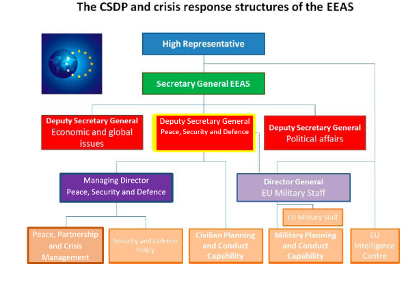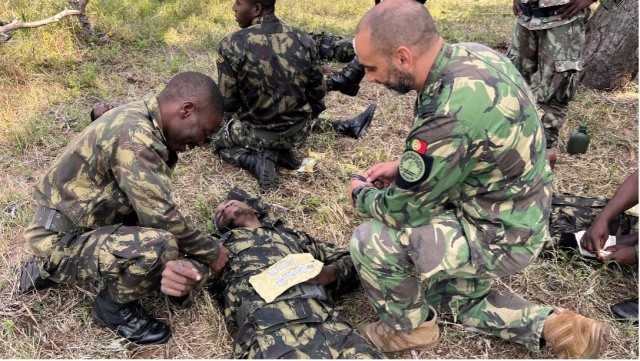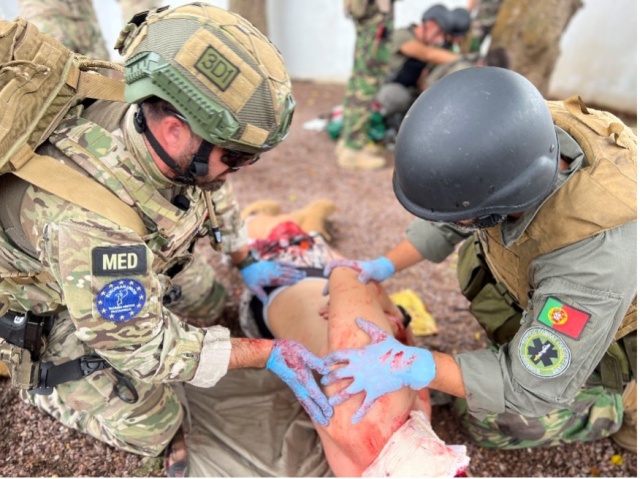
Article: Beatrix Becker, Christian Haggenmiller and Jos Joosten
The EU Integrated Approach to a Common Security and Defence Policy
The EU’s Common Security and Defence Policy (CSDP) has evolved significantly over the last few decades by including tasks such as disarmament, humanitarian aid, conflict prevention, and peacekeeping. The CSDP encompasses both civilian and military operations, with civilian missions focused on crisis intervention and capacity building and military operations providing training and contributing to security in a hostile environment. Currently, the EU conducts 13 civilian missions and 10 military operations and one civil-military initiative, engaging 4.000 civil and military personnel. Key guiding documents for an integrated approach to crisis management include the EU Global Strategy of 2016, emphasizing the security-development nexus and civilian-military synergies, and the EU Strategic Compass for Security and Defence published in 2022. The latter serves as a guide to navigate security challenges, structured around four pillars – act, invest, partner, and secure – and provides a roadmap for proactive and coordinated action.
The EU Military Staff
The EU Military Staff (EUMS) serves as the collective military expertise body within the European External Action Service (EEAS) (Figure1).
Operating under the guidance of the Chair of the European Union Military Committee and the authority of the High Representative of the European Union for Foreign Affairs and Security Policy, the EUMS coordinates military efforts as part of the EU’s Integrated Approach. Its main tasks involve managing military missions and operations, enhancing military capabilities, facilitating early warning, situation assessment, strategic planning, communication systems, concept development, training, and support for partnerships via military-to-military relationships.
EUMS Medical Adviser
In the EUMS Logistic Directorate, two medical advisors play a crucial role in addressing medical issues within CSDP, involving planning, collaboration, and communication with various stakeholders on health and healthcare policy development at the political-strategic level. They contribute to situation awareness, early warning on health security matters, act as a bridge between civil and military and between the EU and the NATO medical communities and participate in strategic planning and medical deployment.
EU Member States (MS) and global stakeholders encounter comparable challenges, including emerging health threats, shortages in both civil and military healthcare personnel, ensuring an adequate supply of medical resources during crises, and maintaining the resilience of healthcare infrastructure in major conflict situations. Addressing these challenges effectively necessitates continued collaboration between civilian and military sectors to increase appropriate stockpiles of medical countermeasures such as personnel protection equipment, medicines and vaccines and joint response capabilities to mass casualties events, specifically if this involves cross border action. Therefore, the EUMS promotes a comprehensive health security approach, encompassing prevention, preparedness, and response, while fostering defence health and healthcare innovation & capability development through expert dialogue.
In addition, continuing close cooperation with NATO, the EUMS has intensified its engagement with other medical institutions within the different departments and executive agencies within the European Commission and non-EU partners and international organizations. This effort has been reinforced by emerging global health threats and an increasing insecure landscape, showing promising advancement towards comprehensive interactions.
Military Planning and Conduct Capability
Since the inception of the Military Planning and Conduct Capability (MPCC) in June 2017, the European Union has established a permanent military command and control structure in Brussels. Currently, this structure oversees non-executive CSDP missions. These missions are conducted to support a host nation with an advisory role only, whereas operations have an executive role.

Figure 1: Organigram EEAS, EUMS and MPCC, according to the CSDP Handbook (Ed. 2022), updated 2024
The MPCC serves as the military strategic level of the EU military chain of command. By 2025, upon achieving Full Operating Capability (FOC), the MPCC is anticipated to become the preferred strategic command and control structure. It will be able to oversee all non-executive military missions, up to two small- scale executive operations or one medium-scale and manage live exercises. Currently, command and control for executive operations is either provided by a national Operation Headquarters (OHQ) offered by a MS, or other ad hoc national OHQ’s, preferably in line with the EU Framework Nation Concept (FNC).The FNC was established in 2002 as a conceptual basis for the conduct of autonomous EU-led military operations and missions. As such, a MS or a group of MS volunteer to assume specific responsibilities in an EU-led military operation or mission over which the EU exercises political control and strategic direction. This MS or group of MS will provide the EU Operation Commander or EU Mission Commander, staff support, the computer information systems and logistic framework, and the bulk of the manoeuvre and combat support capabilities, thereby act- ing as a Framework Nation. EU-led military CSDP operations with recourse to NATO common assets and capabilities are commanded through the establishment of an EU OHQ at SHAPE.
Medical Branch within the MPCC
One critical element of operations is medical support, which is ensured by the Medical Branch. Its role extends beyond planning contributions, by providing a comprehensive medical situational picture and assessment. The MPCC’s Medical Branch (CJMED) works on medical-related contracts and offers support to mission Joint Medical (JMed) teams upon request. Presently, the branch is staffed by a single medical senior officer, who also acts as the Medical Adviser to the Director MPCC. Two additional roles, a Medical Planner and a Force Health Protection Officer, crucial for reaching FOC, are yet to be filled.
Medical Support to Military Missions
Tropical diseases, the risk of (mainly) road traffic accidents and limited host nation support cause a high medical threat level for the deployed forces.
Currently, the MPCC takes responsibilities for the European Union Training Missions (EUTM) in Mali, Mozambique (Figure 2 and 3), Central African Republic and Somalia, the EU Military Partnership Mission in Niger, the European Union Assistance Mission Ukraine and for the EU Security and Defence Initiative in support of West African countries of the Gulf of Guinea.
The EUTM MOZ Medical Team for example, has a dual role in the mission. It is an operational asset, working daily on behalf of the deployed force, through preventive efforts, with lectures to the staff and medical advice to the Mission Force Commander, and also through 24/7 assistance, which ensures the maximum readiness and robustness of our military in the mission.

Figure 2: EUTM Mozambique Trainers from Portugal providing medical care training for the Mozambique Defence Armed Forces (FADM)
In order to have an adequate medical support and advisory system, medical personnel are needed within the missions and in the MPCC in Brussels. Optimal medical support for missions relies on contributions from EU MS. The MPCC orchestrates the overall medical support strategy, including potential Host Nation Support, and coordinates personnel requests through the Force Generation Process. Currently, no EU MS is providing a Role 2 Medical Treatment Facility for any mission; the availability of Role 1 and MEDEVAC capabilities is similarly limited. Filling the JMed positions also presents a considerable challenge in mission and operational areas. As a result, medical support often comes from third nations, e.g. Serbia, or contracted solutions provided by private companies like Iqarus, leading to significant shared costs for the missions.
Figure 3: The EUTM MOZ Medical Team
When operating in regions with elevated medical threat levels, the shortage of military medical personnel in the MPCC in Brussels, in mission and operational areas stands out as a primary challenge for robust medical support in mission and operations. Furthermore, the emphasis on collective defence could restrain the possibilities and/or the willingness of EU MS to contribute to CSDP and hence the operations of the MPCC.
Conclusion
The EU employs an integrated approach to tackle geopolitical security challenges. Effective solutions require continuous collaboration between civilian and military sectors to address common challenges such as emerging health threats and providing health care in remote conflict areas. Shortages of medical personnel, both civilian and military, stand out as one of the most urgent challenges among the multifaceted issues in providing medical support in CSDP missions.
The EUMS is intensifying engagement, not only with NATO but also with other medical institutions within the EU and partner organizations. Driven by shifts in the global landscape, including emerging health threats and increased global insecurity such as the war in Ukraine and the crisis in the Middel East – resulting in a new threat perception among EU MS and institutions – updates in civil military collaborative efforts are necessary to advance an integrated and more comprehensive approach.
Authors:
Lieutenant Colonel (DEU Army) Beatrix Becker
CJMed Military Planning and Conduct Capability
Commander (DEU Navy) Christian Haggenmiller
Lieutenant Colonel (NLD Army) Jos Joosten
Medical Advisers, European Union Military Staff
Rue d’Arlon88, B-1040 Brussels, Belgium
Email: [email protected]
Date: 10/04/2024
Source: European Military Medical Services 2024











